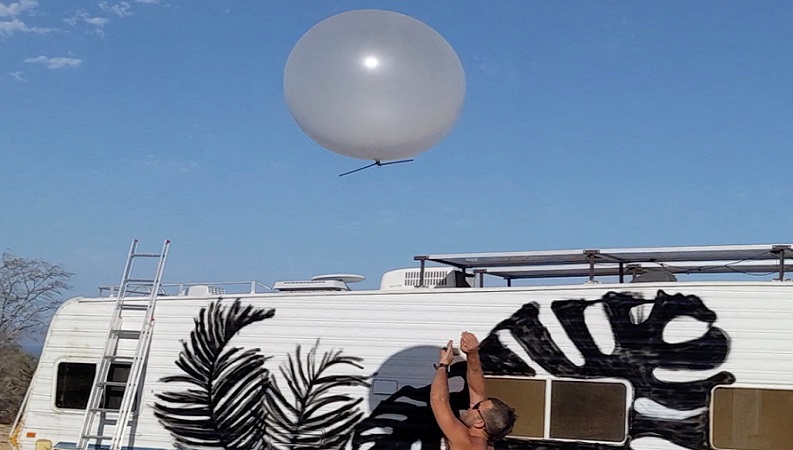The Mexican government will push others to restrict attempts to lessen the effects of climate change by blocking the sun
On an April day, the founder of a U.S. startup called Make Sunsets stood outside a camper van in Mexico’s Baja California and released two weather balloons containing sulfur dioxide into the air, letting them float towards the stratosphere.
American entrepreneur Luke Iseman said the sulfur dioxide in the balloons would deflect sunlight and cool the atmosphere, a controversial climate strategy known as solar geoengineering. Mexico said the launch violated its national sovereignty.
Iseman said he does not know what happened to the balloons. But the unauthorized release, which became public in January, has already had an impact: setting off a series of responses that could set the rules for future study of geoengineering, especially by private companies, in Mexico and around the world.
The Mexican government told Reuters it is now actively drafting “new regulations and standards” to prohibit solar geoengineering inside the country. Mexico also plans to rally other countries to ban the climate strategy, a senior government official told Reuters.
Governments battle over carbon removal and renewables in IPCC report
While the Mexican government announced its intention to ban solar geoengineering in January, its current actions and plans to discuss geoengineering bans with other countries have not been previously reported.
“Progress is being made… to prepare the new regulations and norms on geoengineering, that is, to advance an official Mexican standard that prohibits said activity in the national territory,” Mexico’s environment ministry said in a written statement to Reuters.
The backlash from Mexico arrives as growing numbers of scientists and policy makers are urging further study of solar geoengineering, arguing that emissions cuts alone will not limit dangerous climate change and that additional innovations may be needed.
While calling for further research though, many of these scientists recognise the dangers of geoengineering. Professor James Haywood of Exeter University told Climate Home that putting sulphur into the atmosphere in large quantities was likely to affect winter rainfall patterns in Europe.
Global geoengineering ban
Climate policy experts said Mexico is in a position to help set the rules for future geoengineering research.
“A country like Mexico could start pulling together other countries and say: ‘Let’s work on this together and see how we can ban it together or make it happen properly together,’” said Janos Pasztor, executive director of the Carnegie Climate Governance Initiative (C2G), which advises on governance of solar geoengineering and other climate-altering technologies.
The Mexican environment ministry statement said it would explore using the Convention on Biological Diversity’s call for a moratorium on “climate-related geoengineering activities” to enforce its ban.
Agustin Avila, a senior environment ministry official, told Reuters Mexico will also try to find common ground with other countries on geoengineering at the Cop28 summit in the United Arab Emirates in December.
I’m a COP veteran. Here are 3 suggestions for the new Loss and Damage fund
The Mexican government said Make Sunsets’ balloon launch highlighted the ethical problems of allowing private companies to conduct geoengineering events.
“Why is this company, located in the United States, coming to do experiments in Mexico and not in the United States?” said Avila.
Iseman told Reuters in an email he chose Mexico because “most researchers report that particles launched into the stratosphere near the tropics will create more cooling by staying up longer.” Also, he had a truck and camper in Baja and thinks the region is beautiful, he wrote.
Nations fight to be called climate vulnerable in IPCC report
Stunt makes headlines
David Keith, a professor of applied physics and public policy at Harvard University who has dedicated much of his research to solar geoengineering, called Iseman’s launch a “stunt.”
Iseman has a background in business, not science, but said he consulted with climate scientists. Other innovative startups were ridiculed in their early days, he said. “If the ‘responsible experts’ were solving the problem, we wouldn’t have to,” he said in an email.
Until Mexico’s dispute with Make Sunsets, solar geoengineering had been gaining attention from policy makers and scientists as a possible solution to climate change, and limited research funding.
The strategy, also known as Solar Radiation Management, seeks to mimic the natural cooling effects of volcanic eruptions when ash clouds reflect back enough sunlight to reduce the warming of the earth by using planes or balloons to disperse tiny particles in the stratosphere.
Nations seek compromise on fossil fuel phase-out ahead of Cop28
Research needed?
Last month, 60 scientists including former NASA climate scientist James Hansen signed a letter in support of further research.
The Degrees Initiative, a UK-based non-government group, award
Read More

